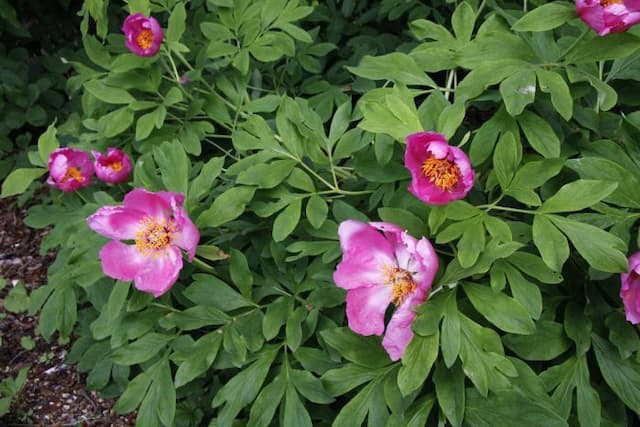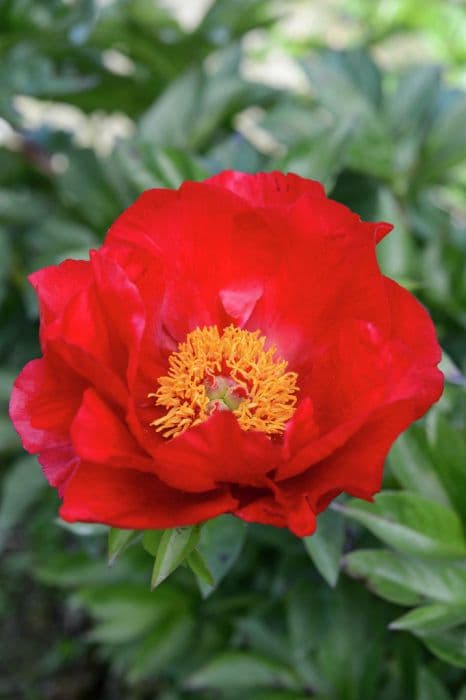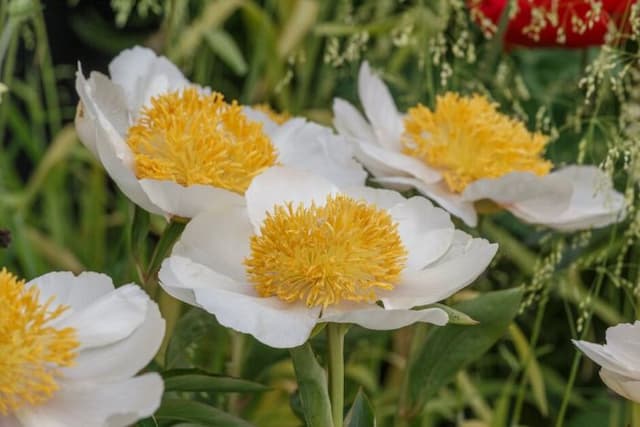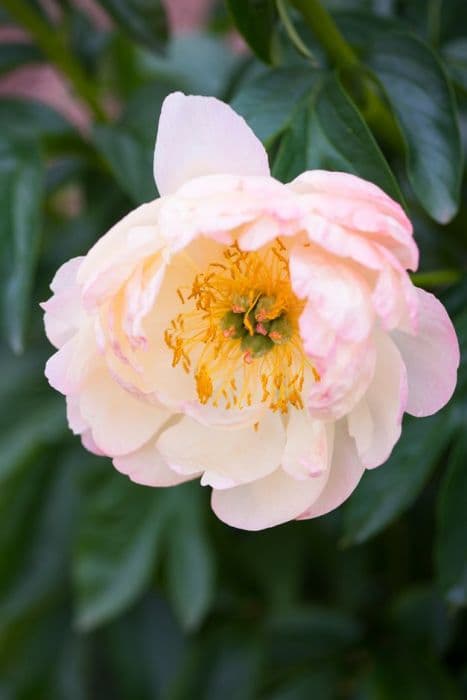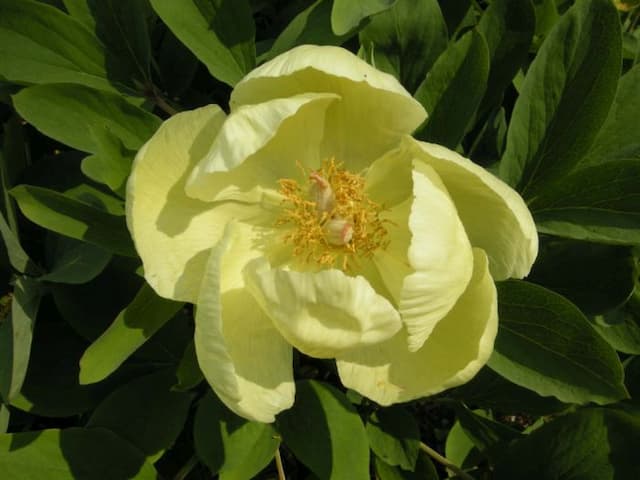Peony 'Buckeye Belle' Paeonia 'Buckeye Belle' (d)

ABOUT
'Buckeye Belle' is a bushy, herbaceous perennial to 90cm tall with dark green, deeply-cut foliage, flushed deep red as it emerges in spring. The semi-double flowers, produced in late spring and early summer, are deep ruby red with a central mass of golden stamens
About this plant
 Names
NamesFamily
Paeoniaceae
Synonyms
Peony, Buckeye Belle Peony
Common names
Paeonia 'Buckeye Belle'
 Characteristics
CharacteristicsLife cycle
Perennials
Foliage type
Deciduous
Color of leaves
Green
Flower color
Red
Height
2 feet (0.61 meters)
Spread
2 feet (0.61 meters)
Plant type
Herbaceous
Hardiness zones
3
Native area
Asia
Benefits
 General Benefits
General Benefits- Attractive Blooms: The Paeonia 'Buckeye Belle' stands out with its large, deep red flowers that add a striking visual interest to any garden.
- Seasonal Interest: It blooms in late spring to early summer, offering seasonal appeal when many other plants are just starting to grow.
- Drought Tolerance: Once established, these peonies are quite drought-tolerant, requiring minimal watering in temperate climates.
- Longevity: Peonies are known for their long lifespan, and with proper care, they can thrive for decades, providing long-term beauty to a garden.
- Cold Hardiness: They are cold hardy and can survive in lower temperatures, making them suitable for a variety of climates.
- Low Maintenance: Aside from occasional watering and deadheading, peonies require very little upkeep, which is ideal for gardeners who prefer low-maintenance plants.
- Attracts Pollinators: The vibrant flowers attract bees and other pollinators, which are beneficial for the health of the garden ecosystem.
- Deer Resistance: Peonies, including the 'Buckeye Belle', are generally resistant to deer, which helps protect them from animal damage in areas where deer are prevalent.
- Cut Flowers: The blooms make excellent cut flowers, with a long vase life and enchanting fragrance, perfect for indoor decoration.
- Structural Interest: Even after the blooms die back, the sturdy stems and lush foliage of the peony plant provide structure and greenery in the garden.
 Medical Properties
Medical Properties- There is no well-documented medicinal use for Paeonia 'Buckeye Belle' specifically in traditional or modern medicine.
- Paeonia species, more broadly, have been used in traditional medicine systems like Traditional Chinese Medicine (TCM) for their potential anti-inflammatory and analgesic properties.
- Compounds found in some Peony species may contain paeoniflorin, which is thought to potentially have effects on the immune system.
 Air-purifying Qualities
Air-purifying QualitiesThis plant is not specifically known for air purifying qualities.
 Other Uses
Other Uses- Peony petals can be used as a natural dye for fabric or paper, imparting gentle shades of pink depending on the concentration of the petal mixture.
- Dried peony petals can be incorporated into potpourri blends to add fragrance and color to a room.
- Peony blooms can be crystallized with egg whites and sugar to create edible decorations for desserts or to be used as a unique garnish.
- The large leaves of the peony can be used in floral crafts, such as making impressions in clay or cement for garden stepping stones.
- Peony flowers can be used in place settings or as natural confetti for weddings and other celebrations for an eco-friendly alternative to paper or plastic.
- During blooming season, peony petals can be floated in bowls of water to create a simple and elegant centerpiece.
- Peonies can be used in photography as a prop or backdrop, helping create lush and vibrant scenes.
- Use peony blossoms to fill out a bridal bouquet, giving fullness and a luxurious appearance with their voluminous petals.
- Peony seed pods, once dried, can be used in autumnal wreaths and arrangements, offering a distinctive and unusual texture.
- At the end of the season, the foliage of peonies, which changes color, can be added to fall bouquets or displays for a burst of natural, rustic charm.
Interesting Facts
 Feng Shui
Feng ShuiThe Peony is often used in Feng Shui for its symbol of beauty, romance, and feminine energy. It can be placed in the love and marriage area of the home or garden to enhance relationships and attract positive energy to one's love life.
 Zodiac Sign Compitability
Zodiac Sign CompitabilityThe Peony is not used in astrology practice.
 Plant Symbolism
Plant Symbolism- Beauty: The peony 'Buckeye Belle' is often associated with beauty due to its large, striking blooms that come in vivid shades of red.
- Romance: With its lush, full petals, peonies symbolize romance and are popular in wedding bouquets and decorations as an emblem of love and happy marriage.
- Prosperity: In some cultures, peonies are believed to bring good fortune and prosperity, making them a common choice in celebratory occasions.
- Honor: The peony represents honor and high esteem. They are sometimes given as a token of respect or as congratulations for a major accomplishment.
- Wealth: Alongside prosperity, they are thought to attract wealth and are used in some traditions to encourage financial success.
- Good luck: In many cultures, peonies are considered a good luck charm, believed to ward off negative energies and attract positive outcomes.
- Bashfulness: According to one myth, nymphs were said to hide within peony petals, symbolically linking the flower to shyness or bashfulness.
 Water
WaterPeonies like 'Buckeye Belle' should be watered deeply once every 7 to 10 days, allowing the soil to dry out between waterings. It is best to avoid overhead watering to prevent fungal diseases. Instead, water at the base of the plant using a soaker hose or drip irrigation to minimize water contact on foliage. The peony may require about 1 inch of water per week, either from rainfall or supplemental watering. During hot or dry periods, increase the frequency of watering to ensure the soil remains moist but not waterlogged.
 Light
LightPeonies such as 'Buckeye Belle' thrive in full sun to light afternoon shade. They require at least 6 hours of sunlight daily to bloom well. The best spot for these plants is in a garden area where they receive unobstructed morning sunlight and some protection from the intense afternoon sun, if possible.
 Temperature
TemperaturePeonies like 'Buckeye Belle' prefer temperate climates and do well in a temperature range between 65°F to 75°F during their growing season. They are hardy from USDA zones 3 to 8, able to withstand minimum winter temperatures down to -40°F and maximum summer temperatures up to 85°F to 90°F. They also need a period of winter chill to set buds for the following spring.
 Pruning
PruningPruning 'Buckeye Belle' peonies should be done to remove spent flowers immediately after blooming to maintain a tidy appearance and prevent seed production, which can divert energy from the plant. In late fall or early winter, after the first frost, cut back the foliage to ground level to prevent overwintering diseases. Prune only when necessary, as peonies do not require frequent cutting back during the growing season.
 Cleaning
CleaningAs needed
 Soil
SoilPeony 'Buckeye Belle' thrives in well-draining soil enriched with organic matter. A mix of two parts garden soil, one part compost or well-rotted manure, and one part perlite or coarse sand is ideal. Maintain a soil pH between 6.0 and 7.0 for optimal growth.
 Repotting
RepottingPeony 'Buckeye Belle' generally does not require frequent repotting. It can be left undisturbed for many years. When planted in the ground, repotting is not necessary. In pots, repot only if it outgrows its container, which can take several years.
 Humidity & Misting
Humidity & MistingPeony 'Buckeye Belle' is tolerant of a range of humidity levels and does not require specific humidity conditions. It is well-suited to the typical outdoor humidity found in most temperate climates.
 Suitable locations
Suitable locationsIndoor
Peony 'Buckeye Belle' is challenging to grow indoors; it needs a cold period.
Outdoor
Plant Peony 'Buckeye Belle' in sun, in fertile, well-drained soil.
Hardiness zone
3-8 USDA
 Life cycle
Life cycleThe life of the Buckeye Belle Peony (Paeonia 'Buckeye Belle') begins with seed germination, which is relatively slow and can require a cold period to break dormancy. Once the seed germinates, the plant grows a root system and sends up shoots, developing into a young plant with characteristic compound leaves. As the plant matures, it forms a clump of stems with deep green foliage and in late spring to early summer, it produces large, dark red flowers with yellow stamens at the center. After flowering, the plant sets seed in the form of a dry, dehiscent fruit called a follicle, which opens to release the seeds. In autumn, the foliage of the Buckeye Belle Peony dies back to the ground, and the plant enters a period of dormancy through the winter. The life cycle repeats when the peony emerges again in the spring, drawing energy from the tuberous root system to start the growth cycle anew.
 Propogation
PropogationPropogation time
Early fall
Propogation: The Paeonia 'Buckeye Belle', commonly known as the peony, is most effectively propagated by division. This process is typically carried out in the fall when the plant has become dormant, after the leaves have died back. To propagate peonies by division, carefully dig up the peony clump, taking care not to damage the roots. Wash the soil off the roots so that the individual eyes or shoots are visible. Using a sharp knife, divide the clump into smaller sections, ensuring that each section has at least 3-5 eyes. These sections can then be planted in a well-drained soil enriched with compost, with the eyes situated about 1-2 inches (2.5-5 cm) below the soil surface to encourage successful growth. Water the new divisions thoroughly to settle the soil around the roots.
